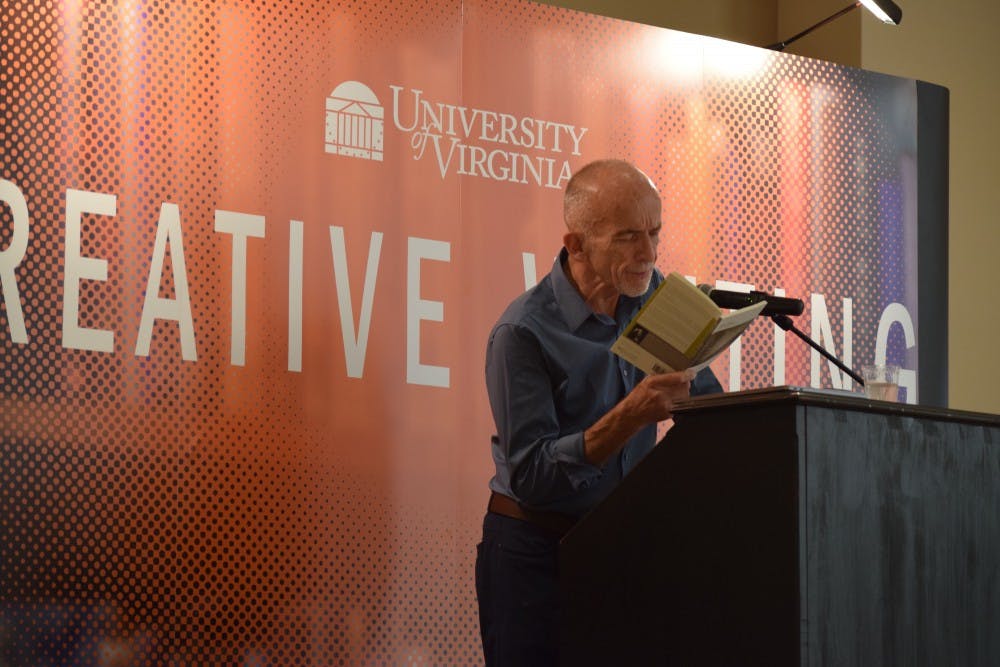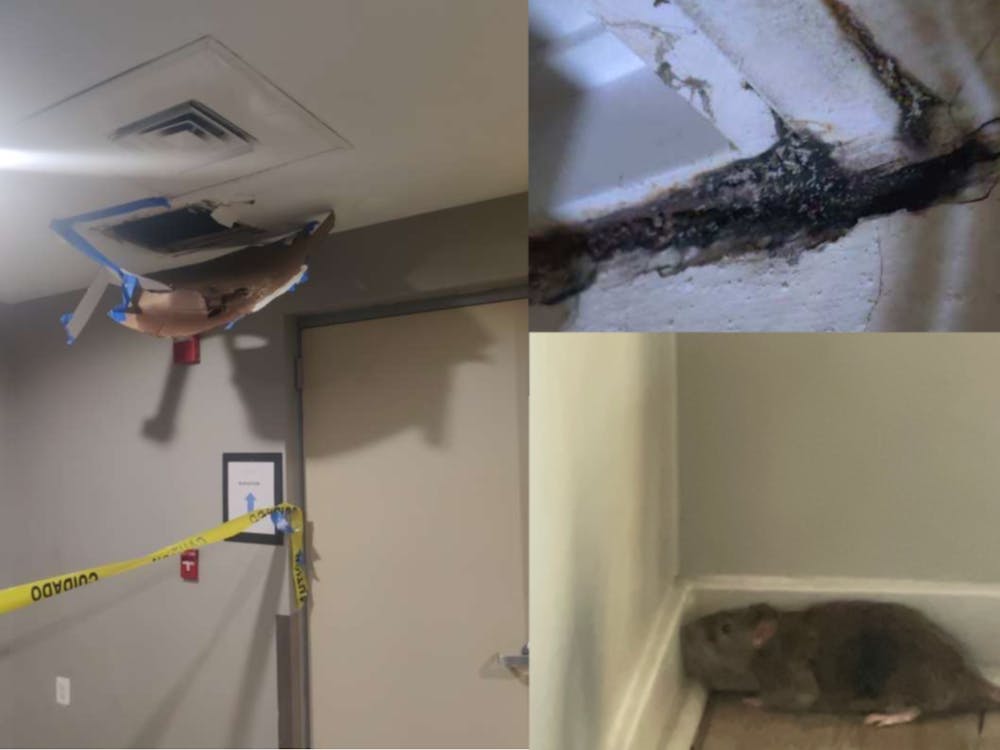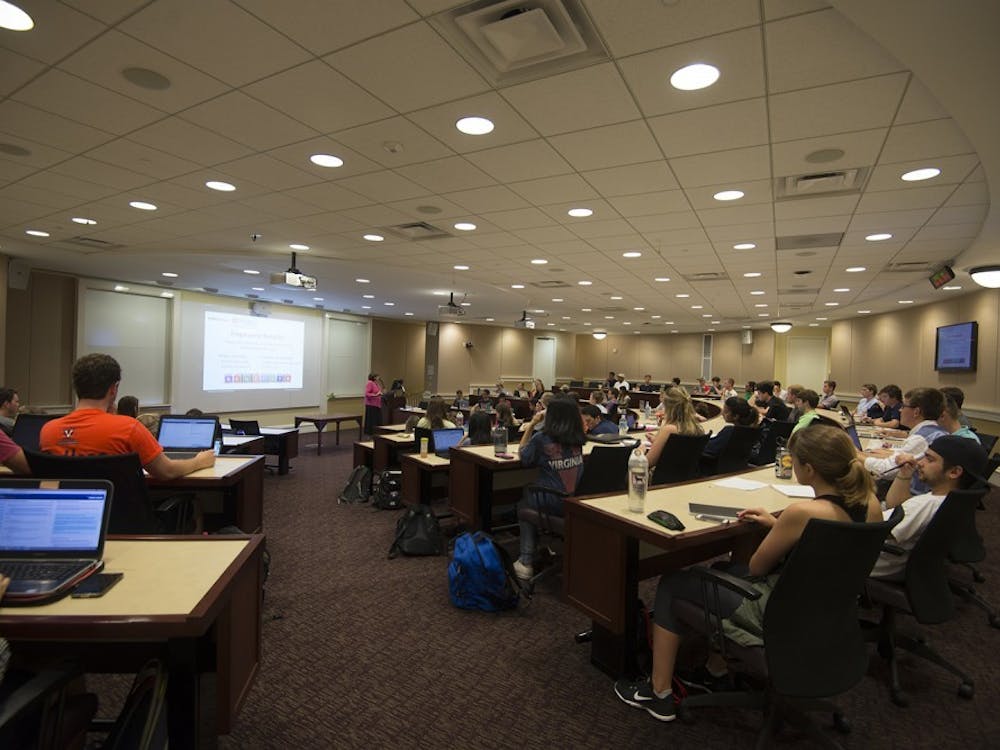Each year, the University offers two semester-long positions in writer- and artist-in-residence programs for writers, poets and artists of global acclaim to stay on or around Grounds to instruct and interact with students. After the white supremacist rallies of Aug. 11 and 12, 2017 — where the violent Unite the Right rally resulted in the death of counter-protester Heather Heyer — some members of the University’s artistic community believe these residence programs act as a meeting point between controversy and creativity.
According to Marisa Williamson, a Ruffin Distinguished Artist-in-Residence for the Spring 2018 semester, her residency was shaped by these tensions.
“I feel I have a visual and a literal language now that I’m able to use that may be unfamiliar to people who are shocked or surprised by the events of August 11th [and 12th],” Williamson said. “Coming to U.Va. at the time that I did allowed me to give art students and other practitioners there another way to talk about current events.”
These programs found their early roots in the 1950s with the residency of Nobel Prize-winning author William Faulkner, with other notable authors like Katherine Anne Porter and John Dos Passos that same decade.
However, in the aftermath of events like the white supremacist rallies, some say that the University community can bring new ideas and inspiration to the works of writers- and artists-in-residence who willingly call Charlottesville their temporary home.
“For me, the art world doesn’t just happen in New York or in L.A.,” Williamson said. “I think U.Va. ... has really interesting and pertinent questions around monuments, and community, and history, so for me it was perfect marriage of all the interesting questions in the art world.”
Director of Creative Writing Lisa Spaar said that visiting writers often mention to her how paramount their residencies feel in the wake of these events.
“Suddenly Charlottesville is on the map — it’s a place that people talk about, like Ferguson,” Spaar said. “A lot of writers feel that coming to Charlottesville and bringing their words ... and interacting here is important.”
Beyond the scope of Charlottesville’s influence, some University faculty and students believe that these programs are important because they allow residents to demonstrate their real-world expertise and instruct a new generation of creative minds, and they hope to continue working to expand the programs by incorporating the broader community into its events.
The programs then and now
Spaar said highly-regarded authors who became writers-in-residence are important because these professionals show students that working and living as a writer is achievable.
Third-year College student Lamar Johnson said that as an English major, many of the books that he and other students read are written by authors from hundreds of years ago, so he appreciates having current publishing authors on Grounds to give contemporary perspectives on the craft of writing and the state of literature in today’s world.
“We’re mostly reading these books that are considered classics from a bygone age,” Johnson said. “It’s interesting to have people around that are recognized as classics of modern day that are still alive so you can still ask them questions.”
In the early 1970s, Columbia University graduate Gregory Orr was hired as a professor of poetry and later founded the Master of Fine Arts Program in Writing at the University. A decade later, a donation from the Dungannon Foundation initiated the Rea Visiting Writers and Lecturers Program, which to this day brings poets and writers to the University for a week-long stay. Rea residents workshop MFA student manuscripts, lead a public reading and have a writing discussion with MFA and area concentration undergraduate students during their residency. Previous Rea residents have included Aminatta Forna, John Edgar Wideman and Mark Doty.
In 2013, a donation from the Kapnick family established the longer Kapnick Foundation Distinguished Writers-in-Residence Program, whose residencies vary in length but can last up to a semester. According to Doty, the Kapnicks funded the endowment because their daughter enjoyed a Creative Writing course she took at the University.
Since 2012, the Ruffin Distinguished Artists in Residence program — funded by the Peter B. and Adeline W. Ruffin Foundation — has also invited artists to teach, exhibit work and consult with students. Peter Ruffin was an undergraduate at the University in the 1920’s, and he and his family were prominent benefactors — Ruffin Hall on Arts Grounds is also named after them.
Spaar said that the remuneration residents receive varies in each program for several reasons, including length of stay, travel expenses and agent agreements. She said that there is not a set figure for either program.
Selecting the residents
In order to procure a set of diverse professionals for a non-application based position, the selection of writers- and artists-in-residence takes multiple opinions into account, Spaar says. For the Rea program, Creative Writing faculty create an agreed-upon list of residency candidates that honors student requests. Spaar says Rea writers need not necessarily be well established — though some are — but must have promising teaching skill and writing potential.
“We tally up how many people got how many votes and then we start to contact people,” Spaar said. “Our faculty are pretty diverse in many ways … so when we put in an ask for our favorite visitor, that’s going to naturally mean we have a pretty diverse pool of people coming in.”
To select Kapnick residents, Spaar says decisions are made in accordance with terms established by the Kapnick Foundation.
“The Kapnick Writer decision is made by the Director, Department Chair, and Dean of Arts & Sciences, with the advisement of faculty as well as graduate and undergraduate students,” Spaar said in an email. “These writers must have an international stature and be highly prominent and somewhat advanced in their fields. They are meant to be an inspiring presence not only in the Creative Writing program, but in the community as well.”
Internationally recognized poet and two-time writer-in-residence Mark Doty is completing his second stay as a Kapnick resident this Fall 2018 semester, the first of any Kapnick writer to complete two tenures. Doty says he was honored to receive a second offer and referred to the quality of both previous residents and the students as the reason for his return. Doty named Pulitzer Prize-winning author Junot Díaz as one figure who he was honored to succeed in the Kapnick program.
A famed figure of the literary world and author of the novel “The Brief Wondrous Life of Oscar Wao” and short story collection, “This is How You Lose Her,” Junot Díaz served as the University’s fourth Kapnick writer early in the Spring 2017 semester. His involvement with the program included a public lecture, reading and discussion, as well as consultations with MFA and undergraduate prose students.
In the art program, a variety of resources are available to professionals to produce the best experiences possible. After initially interviewing for a job at the University, Williamson was eager to serve at a University with such cross-disciplinary interaction. Much of Williamson’s work has surrounded Monticello and Sally Hemings, so access to relevant information proved beneficial to her production.
“The idea of working with historians and architects was really appealing to me,” Williamson said. “It meant that the work I do, which is often … producing engagement experiences, could be supported by having so many resources.”
What the residents do
Aside from using the time to produce work if they choose to do so and serving as examples of success in creative pursuits, writers- and artists-in-residence offer MFA students support and critique to better their work. There are only twenty students in the Creative Writing MFA program at a time. Personal access to these residents would be more difficult for students outside of the University setting.
“I work mostly one-to-one with students. I read their poems, we have conferences, we talk about particulars and how they can make their poem stronger,” Doty said. “I also really like talking to them about the vision in their work and what they’re trying to accomplish.”
Innate to each residency’s intimate community feel is the ability to deepen discussions of art, writing and even the challenges of pursuing careers in these fields, according to Williamson.
“We had a lot of interesting conversations … of how students plan to move forward with art and how the larger economy can make it very challenging,” Williamson said.
Writers- and artists-in-residence offer tailored advice to improve graduate student work, and part of each resident writer’s stay is the commitment to read and offer improvements to student manuscripts in face-to-face meetings.
Johnson says students studying English as undergraduates, however, have less interaction with residents. He explains that resident events, sometimes assigned as a class-related obligation, are often poorly advertised and lightly attended by undergraduate students.
“The only people I know that work one-on-one with [writers-in-residence] are the MFA students,” Johnson said.
One such MFA student was now-published author Mary Ann Samyn, who expressed gratitude for her involvement with the program in an email to The Cavalier Daily.
“[Writers-in-residence] are always valuable,” Samyn said. “It's an opportunity to show your work to another writer, to get a different perspective.”
Samyn named 2014-2015 Poet Laureate of the United States Charles Wright, Orr and 1993-1995 Poet Laureate of the United States Rita Dove as some of the teachers she was thankful to have worked with during her time as an MFA student.
Spaar said the undergraduate area concentrations in Poetry and Literary Prose are one way for undergraduates to receive a similar form of mentorship from MFA graduate students. She also said that these graduate student writers often capitalize on the opportunity to form relationships with these established authors, which can lead to benefits that extend outside of their mutual time in Charlottesville.
“Some writers in particular have had help getting agents or books published through contacts that they’ve had,” Spaar said.
The Charlottesville influence
Coming from across the country and globe, the residents’ extensive backgrounds bring diversity to the programs. However, staying at the University influences many residents in the same manner. With its rich, controversial history and current events, many residents say the University environment shapes their art and writing.
“It has made work I had been doing for a long time feel all the more relevant,” Williamson said, “having done some of [my work] at Monticello early on and having it revolve around Sally Hemings.”
Williamson credits her tenure in Charlottesville with influencing projects even after her time as a resident ended.
“My upcoming project, the Hemings Foundation, which is something that came out of my work at U.Va., attempts to make [artistic] practices sustainable for artists of color and also tries to support really young artists,” Williamson said.
Doty said that much of Charlottesville’s history has culminated into modern issues like gentrification and racism, and said being with other creative-minded people in the wake of the Aug. 11 and 12 tragedies felt urgent because it provided an opportunity to discuss these issues.
“I was just riveted by that awful spectacle,” Doty said. “There are clearly many conflicts and struggles here which are sort of beneath the surface.”
Doty’s belief in the importance of empathy as a solution to these problems led to him to hold three lectures on poetry and compassion last year — Spaar similarly attests to the impact Charlottesville has had on residents.
“Our writers have been saying to us how important it is to come to Charlottesville right now,” Spaar said. “We’re sitting right on top of everything that’s important in America right now. So, we have this great opportunity to further that conversation and deepen it through these visitors.”
The future of the programs
As the University progresses, the expectation of many is that these programs continue to catalyze valuable interactions. Williamson hopes that in the future, the University will host less-established artists who would benefit from the resources of a residency.
“I think [the Ruffin program] should look at artists who could really use the bridge that it offers,” Williamson said. “There are early career artists who could really use that free time.”
Considering the public, Spaar says that the Creative Writing department hopes to broaden its impact on the larger community. Public events are advertised in local venues, news outlets and Facebook, but the hope is that in the coming years, these free events will become even more influential in the local arena.
“One of the things we’ve been talking about is maybe holding more of our events off-Grounds for the community,” Spaar said. “Just so that people who live downtown and for whom the University might seem inaccessible ... can make their way.”
With the continuation of the Rea, Kapnick and Ruffin programs, the exchange of new ideas remains to many a part of the University’s identity. Often, these residency programs make a lasting impression on the professionals, as shown by residency-inspired works such as Williamson’s Sally Hemings Foundation and Doty’s Poetry and Compassion lectures.
“Coming to U.Va. ... was really great for my practice,” Williamson said. “I was getting as much, if not more, out of it I imagine maybe than I gave.”





